[ad_1]
Editor’s Note: “The Trek: A Migrant Trail to America” premieres on April 16 at 8 p.m. ET/PT on CNN’s new Sunday primetime series, The Whole Story with Anderson Cooper.
Darién Gap, Colombia and Panama
CNN
—
There is always a crowd, but it can feel very lonely.
To get closer to freedom, they have risked it all.
Masked robbers and rapists. Exhaustion, snakebites, broken ankles. Murder and hunger.
Having to choose who to help and who to leave behind.
The trek across the Darién Gap, a stretch of remote, roadless, mountainous rainforest connecting South and Central America, is one of the most popular and perilous walks on earth.
Almost 250,000 people made the crossing in 2022, fueled by economic and humanitarian disasters – nearly double the figures from the year before, and 20 times the annual average from 2010 to 2020. Early data for 2023 shows six times as many made the trek from January to March, 87,390 compared to 13,791 last year, a record, according to Panamanian authorities.
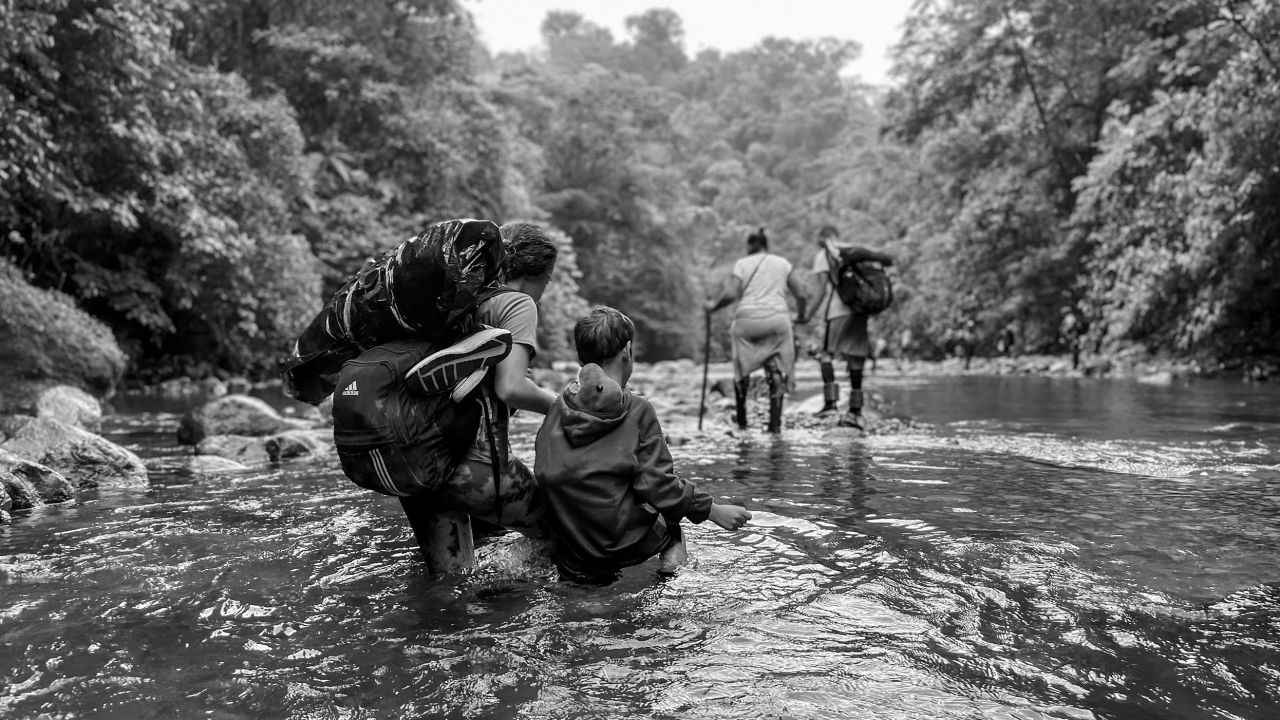
They all share the same goal: to make it to the United States.
And they keep coming, no matter how much harder that dream becomes to realize.
A team of CNN journalists made the nearly 70-mile journey by foot in February, interviewing migrants, guides, locals and officials about why so many are taking the risk, braving unforgiving terrain, extortion and violence.
The route took five days, starting outside a Colombian seaside town, traversing through farming communities, ascending a steep mountain, cutting across muddy, dense rainforest and rivers before reaching a government-run camp in Panama.
Along the way, it became evident that the cartel overseeing the route is making millions off a highly organized smuggling business, pushing as many people as possible through what amounts to a hole in the fence for migrants moving north, the distant American dream their only lodestar.
At dusk, the arid, dusty camp on the banks of the Acandí Seco river near Acandí, Colombia, hums with expectation.
Hundreds of people are gathered in dozens of tiny disposable tents on a stretch of farmland controlled by a drug cartel, close to the Colombian border with Panama. The route ahead of them will be arduous and life-threatening.
But many are naïve to what lies ahead. They’ve been told that the days of trekking are few and easy, and they can pack light.
But money, not prayer, will decide who will survive the journey.
People are the new commodity for cartels, perhaps preferable to drugs. These human packages move themselves. Rivals do not try to steal them. Each migrant pays at least $400 for access to the jungle passage and absorbs all the risks themselves. According to CNN’s calculations, the smuggling trade earns the cartel tens of millions of dollars annually.
The US, Panama and Colombia announced on April 11 that they will launch a 60-day campaign aimed at ending illegal migration through the Darién Gap, which they said “leads to death and exploitation of vulnerable people for significant profit.” In a joint statement, the countries added that they will also use “new lawful and flexible pathways for tens of thousands of migrants and refugees as an alternative to irregular migration,” but did not elaborate any further.
A senior US State Department official declined to give a figure for cartel earnings. “This is definitely big business, but it is a business that has no thought towards safety or suffering or well-being… just collecting the money and moving people,” the official said.
This cash has made an already omnipotent cartel even more powerful. This seems to be a no-go area for the Colombian government. Their last visible presence was in Necoclí, a tiny beachfront town miles away, packed with migrants, overseen by a few police.
Migrants at the Acandí Seco camp are given pink wristbands – like those handed out in a nightclub – denoting their right to walk here. The level of organization is palpable and parading that sophistication may in fact be the reason the cartel has granted us permission to walk their route.
CNN has changed the names of the migrants interviewed for this report for their safety.
Manuel, 29, and his wife Tamara, finally decided to flee Venezuela with their children, after years scrabbling to secure food and other basic necessities. A socioeconomic crisis fueled by President Nicolás Maduro’s authoritarian government, worsened by the global pandemic and US sanctions, has led one in four Venezuelans to flee the country since 2015.
“It’s thanks to our beautiful president … the dictatorship – why we’re in this sh*t… We had been planning this for a while when we saw the news that the US was helping us – the immigrants. So here we are now. Living the journey,” Manuel said. But it was unclear what help he was referring to.
“Trusting in God to leave,” interrupted Tamara. “It’s all of us, or no one,” added Manuel, on the decision to bring their two young children.
Their fate will be impacted by Washington’s recent changes in immigration policy.
Last October, the US government blocked entry to Venezuelans arriving “without authorization” on its southern border, invoking a Trump-era pandemic restriction, known as Title 42. The Biden administration has since expanded Title 42, allowing migrants who might otherwise qualify for asylum to be swiftly expelled, turned back to Mexico or sent directly to their home countries. The measure is expected to expire in early May.
The government has said it will allow a small number to apply for legal entry, if they have an American sponsor – 30,000 individuals per month from Venezuela, Nicaragua, Haiti and Cuba.
Like many others CNN interviewed, those policy changes had not impacted Manuel and Tamara’s decision to go north.
As dawn drags people from their tents, the cartel’s mechanics pick up. Christian pop songs are played to rally those at the start line, where cartel guides dispense advice. “Please, patience is the virtue of the wise,” says one organizer through a megaphone. “The first ones will be the last. The last ones will be the first. That is why we shouldn’t run. Racing brings fatigue.”
But no one is paying attention. Everyone is jostling as though they’re sprinters preparing to step into starting blocks. Small backpacks, one bottle of water, sneakers – what is comfortable to move with now, won’t suffice in the days of dense jungle ahead.
There is a call for attention, a pause, and then they are allowed to begin walking.
Sunlight reveals a crowd of over 800 this morning alone – the same as the daily average for January and February, according to the United Nation’s International Organization for Migration (IOM). These months in the dry season are normally the slowest on the route, because the rivers are too low to ferry migrants on boats, and the huge uptick is raising fears of more record-breaking numbers ahead.
The volume of children is staggering. Some are carried, others dragged by the hand. The 66-mile route through the Darién Gap is a minefield of lethal snakes, slimy rock, and erratic riverbeds, that challenges most adults, leaving many exhausted, dehydrated, sick, injured, or worse.
Yet the number of children is growing. A record 40,438 crossed last year, Panamanian migration data shows. UNICEF reported late last year that half of them were under five, and around 900 were unaccompanied. In January and February of this year, Panama recorded 9,683 minors crossing, a seven-fold increase compared to the same period in 2022. In March, the number hit 7,200.
Jean-Pierre is carrying his son, Louvens, who was sick before he’d even started. Strapped to his father’s chest, he’s weak and coughing. But Jean-Pierre pushes on, their fee already paid. There is no going back. Their home of Haiti – where gang violence, a failed government and the worst malnutrition crisis in decades make daily life untenable – is behind them. And impossible choices lie ahead.
Within minutes, the first obstacle is clear: water. The route, which crisscrosses the Acandí Seco, Tuquesa, Cañas Blancas and Marraganti rivers, is constantly wet, muddy, and humid. Most migrants wear cheap rain boots and synthetic socks, in which their feet slowly curdle. They provide little ankle support and fill with water, leading some to cut holes in the rubber to let it drain out.
Physical distress is a business opportunity for the cartel. Once the riverbeds turn to an ascent up a mountain to the Panamanian border, porters offer their services. Each wear either the yellow or blue Colombian team’s national soccer jersey with a number, to ease identification, and charge $20 to move a bag uphill – or even for $100, a child.
“Hey, my kings, my queens! Whoever feels tired, I’m here,” one shouts.
The route they are walking is new, opened by the cartel just 12 days earlier. The main, older route, via a crossing called Las Tecas, had become littered with discarded clothes, tents, refuse and even corpses. The cartel, locals tell us, sought a more organized, less dangerous alternative – more opportunities to earn more cash.
At one of several huts where locals sell cold soda or clean water with cartel permission at a mark-up, is Wilson. Aged about five, he has been separated from his parents. They gave him to a porter to carry, who raced ahead.
Wilson shakes his head emphatically when asked if he is going to the US. “To Miami,” he says. “Dad is going to build a swimming pool.” Asked about his future there, he says: “I want to be a fireman. And my sister has chosen to be a nurse.” He calls back down the trail: “Papa, Papa!” His father is nowhere to be seen.
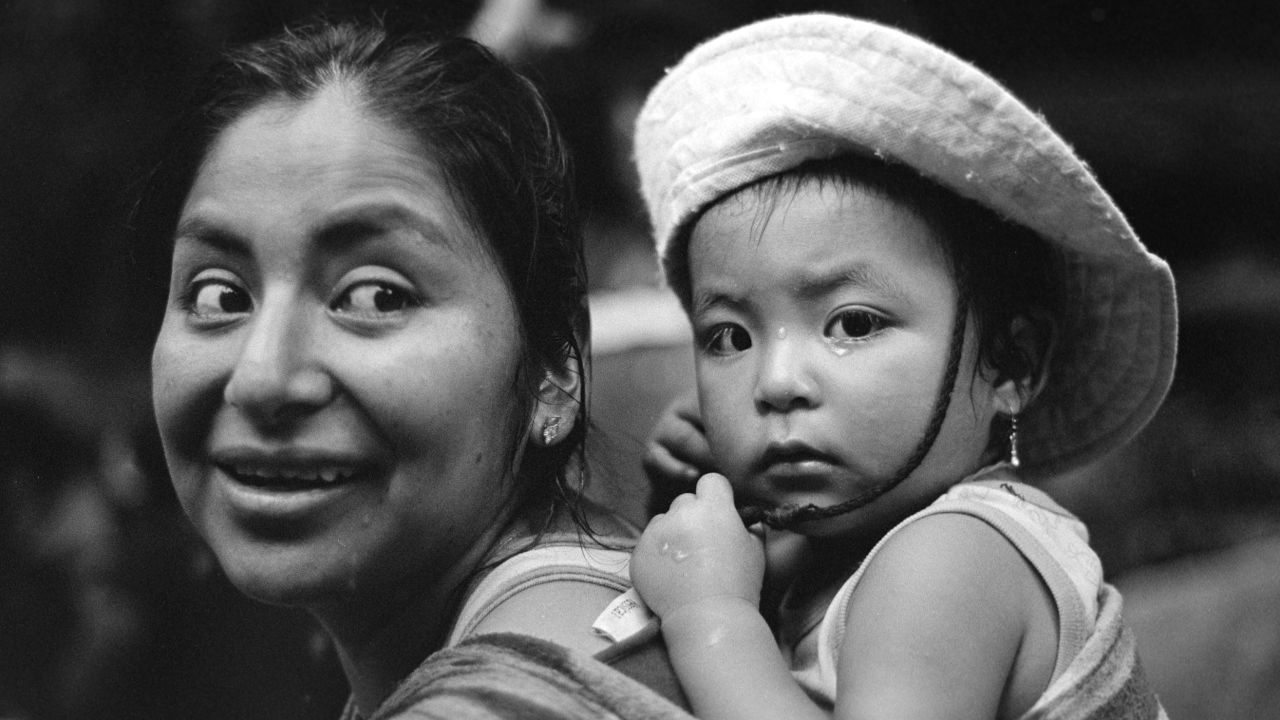
In the background is the constant advice of the cartel guides. “Gentlemen take your time,” says one named Jose. “We won’t get to the border today. We have two hours of climbing left.” He urges them to make use of the stream nearby, already crowded with people. “Fill up your water. One bottle of water up there costs you five dollars,” he says pointing up the hill. “I know that a lot of you don’t have the money to buy that, so better to take your water here.”
The terrain is unforgiving, and the steep climb is particularly punishing on Jean-Pierre and his sick son Louvens, for whom breathing is audibly hard work. Other migrants offer suggestions: “Perhaps he is overheating in his thick wool hat. Maybe he needs more water?” His father struggles to move even himself uphill.
Six hundred meters up the slope, bright light pierces the jungle canopy. Wooden platforms cover the clearing floor, and the buzz of chainsaws blends with music better suited to a festival. Drinks, shoes, and food are on sale. The route is so new, the cartel is cutting space for its clients into the forest as fast as they can arrive.
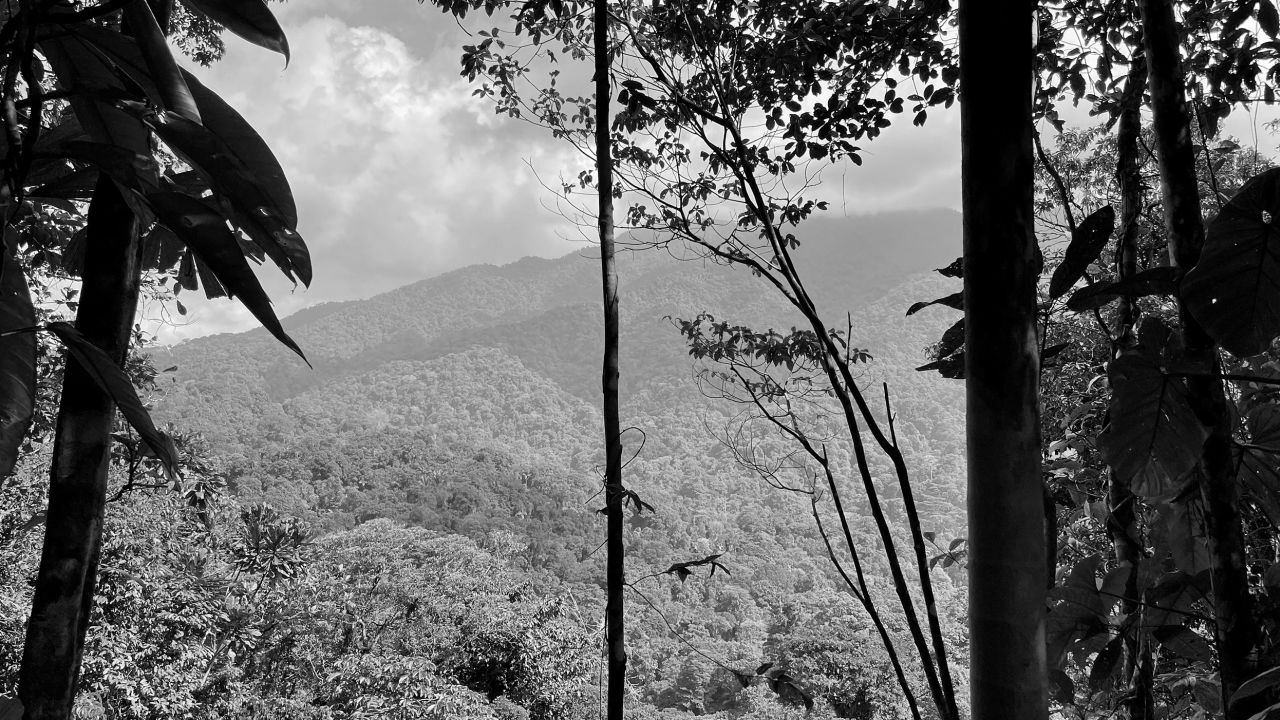
Tents are pitched on fallen branches. Gatorades are cheerfully sold for $4. “Keep a lookout for the snake,” one machete-wielding guide warns. Dusk is a clatter of late arrivals, new tents being pitched, and attempts to sleep. The next day, and those after it, will be arduous.
The second dawn breaks and the hillside is a mess of tents and anticipation. Water, hot rice, coffee – people buy what they can, many still unaware this will be their last chance to get food on the route.
The size of the group has swollen and there is a jostle to get into position, as they wait for the guide Jose’s signal to start. They have learned that being last means you have to wait for everyone ahead of you to clear any obstacles.
Jose barks chilling advice: “Take care of your children! A friend or anyone could take your child and sell their organs. Don’t give them over to a stranger.”
As the crowd moves up the slope, the mist clings to the trees, making the climb feel steeper still. Some children embrace the challenge, bounding upwards playfully.
A group of three Venezuelan siblings make light work of the muddy slope together. “I have to hold the stick so that you guys can grab me,” says the youngest to her brother and sister. The older sister strips to her socks when the viscous mud starts claiming shoes. Their mother adds: “You’re my warrior, you hear baby?”
This morning, Louvens is looking worse. The difficulty of the climb seems to have left Jean-Pierre too exhausted to fully intervene. “He’s sleeping,” he says of his slumped son, whose breathing is labored over the sound of boots in the mud.
Some walkers appear to have come to the jungle with little bar their will to keep moving. One Haitian man is wearing only flimsy rubber shoes, a wool sweater draped across his shoulders, and carrying three ruffled trash bags.
Others are propelled by the horrors of what they have fled. Yendri, 20, and her mother Maria, 58, left Venezuela when Yendri’s university friends were shot dead in criminal attacks commonplace in the country, where the murder rate is one of the highest in the world. “It’s so hard to live there. It’s very dangerous – we live with a lot of violence. I studied with two people that were killed.”
Her mother Maria was a professor, earning $16 a month – barely enough to eat. “I’m going, little by little,” she says. “I sat down to rest and to eat breakfast so that we continue to have strength.”
Another is Ling, from Wuhan, the epicenter of the Covid-19 pandemic. He learned about the Darién Gap by evading the Chinese firewall, and then researching the walk on TikTok. “Hong Kong, then Thailand, then Turkey and then Ecuador,” he rattles off his route to the riverbank where we meet.
“Many Chinese come here … Because Chinese society is not very good for life,” Ling adds while pausing to rest. He has also run out of food already. His move split his parents, he says. His father was for it; his mother wanted a traditional life and marriage for him. Around 2,200 Chinese citizens made the trek in January and February this year – more than in all of 2022, according to Panamanian government data.
The last bit of Colombian territory grates, one father slipping as he carries his son on his back. Then the sky clears. The summit of the hill is the border between Panama and Colombia, marked with a hand-daubed sign of two flags. A canopy provides some shelter, and parents rest on logs. Younger walkers take smiling selfies. There is a sense of euphoria, which will evaporate within a few hundred yards.
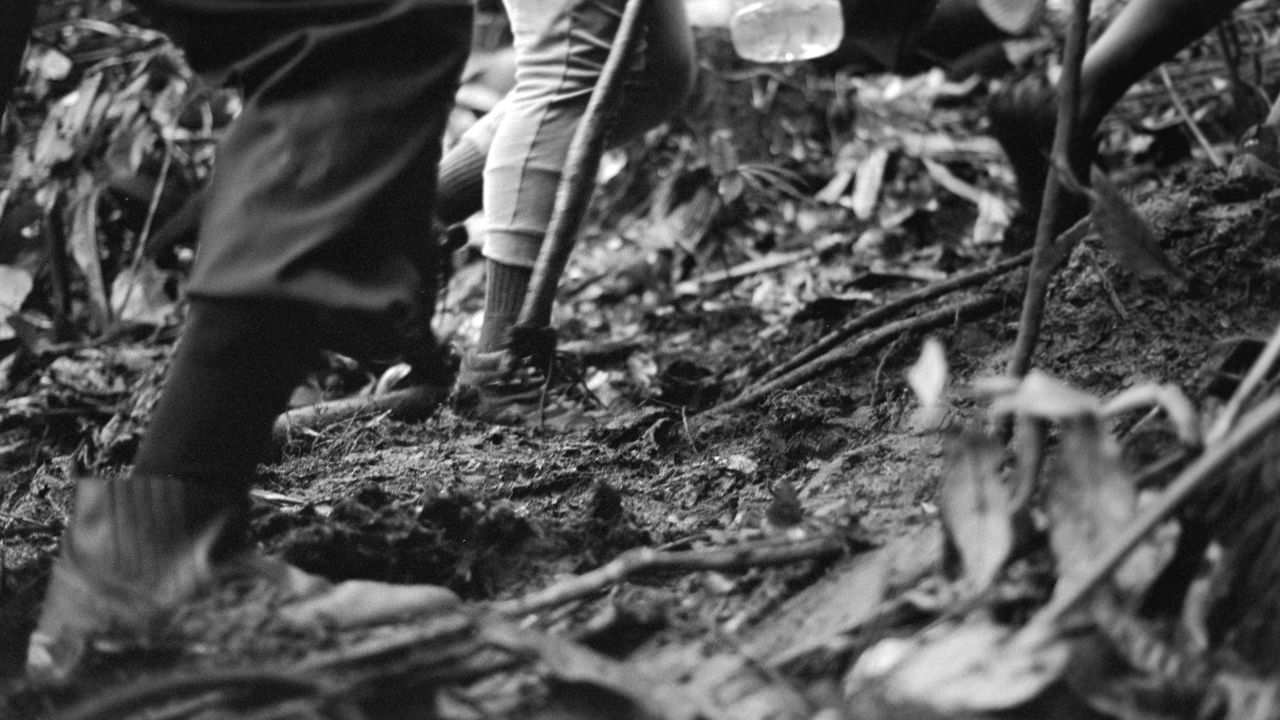
They are about to leave the grasp of the cash-hungry Colombian cartel and set off alone into Panama. The porters offer parting wisdom: “The blessing of the almighty is with you,” says one. “Don’t fight on the way. Help whoever is in need, because you never know when you’re going to need help.”
During this pause they can take stock of who is suffering most acutely. Anna, 12, who is disabled and has epileptic convulsions, lies shaking on the chest of her mother, Natalia. “Her fever hasn’t dropped,” she says. “I didn’t bring a thermometer.”
Like many here, Natalia says she was told the walk would be a lot shorter – only two hours’ descent ahead, she says. The scale of the deceit has begun to emerge, and the ground is about to literally turn on them.
Once in Panama, the cartel falls away, reaching the end of their territory, as does the firm terrain. On the other side of the border lies a steep drop down the mountain, interrupted by roots, trees and rocks. Many stumble or slide uncontrollably. Mud grips your feet.
Maria moves forwards slowly. “Don’t take me through the high parts,” she begs Yendri.
Natalia has asked a Haitian migrant to carry her sick daughter ahead, but he soon tires. Anna sits by the side of the trail, alone, shivering.
The man who was carrying her has started to make a stretcher from nearby canes cut from the jungle but needs help. They cannot move her further away from her mother, who is back down the trail and knows what Anna needs. But they cannot take her back to Natalia for help, as the climb up has already exhausted him.
Although the trail has been open for less than two weeks, the path is already littered with refuse. An abandoned bow tie, empty tents, clothing, used diapers, personal documents – all scattered across the foliage, fragments of lives abandoned on the move.
In one clearing, there is finally a moment of hope. Louvens, whose deterioration we had seen throughout the first days of the walk, is alert and smiling again after a miraculous recovery. He clambers over his father’s friends as they rest by the path.
It is another two hours’ hard scrabble until the sound of the water surges. The forest opens, and the jungle floor is awash with tent poles, children, makeshift pots and stoves. People perch on every rock in the river, the sheer volume of migrants laid bare in one confluence. This is just the tail end of this morning’s group.
There is a race to finish eating and washing before dark. Yet even in the night, new arrivals to the camp are cheered as they emerge from the path.
On the third morning, the real length of the journey comes into focus.
Jean-Pierre was told the whole walk would last 48 hours. “Right now, I don’t have enough food,” he says.
Natalia, who has been reunited with her daughter, Anna, says she was told the descent to the boats from the summit would last only two days. It will be at least three. “‘No, your daughter can walk, this is easy,’” she says she was told by a Colombian guide. “But it’s not… since then, all I do is pay and pay,” she sobs. She and Anna are unable to move forward and are running short on food.
On the winding route, chokepoints emerge at tree roots and pinnacles. Traffic jams form, with whole families spending hours on their feet waiting. In about an hour we move only a hundred meters.
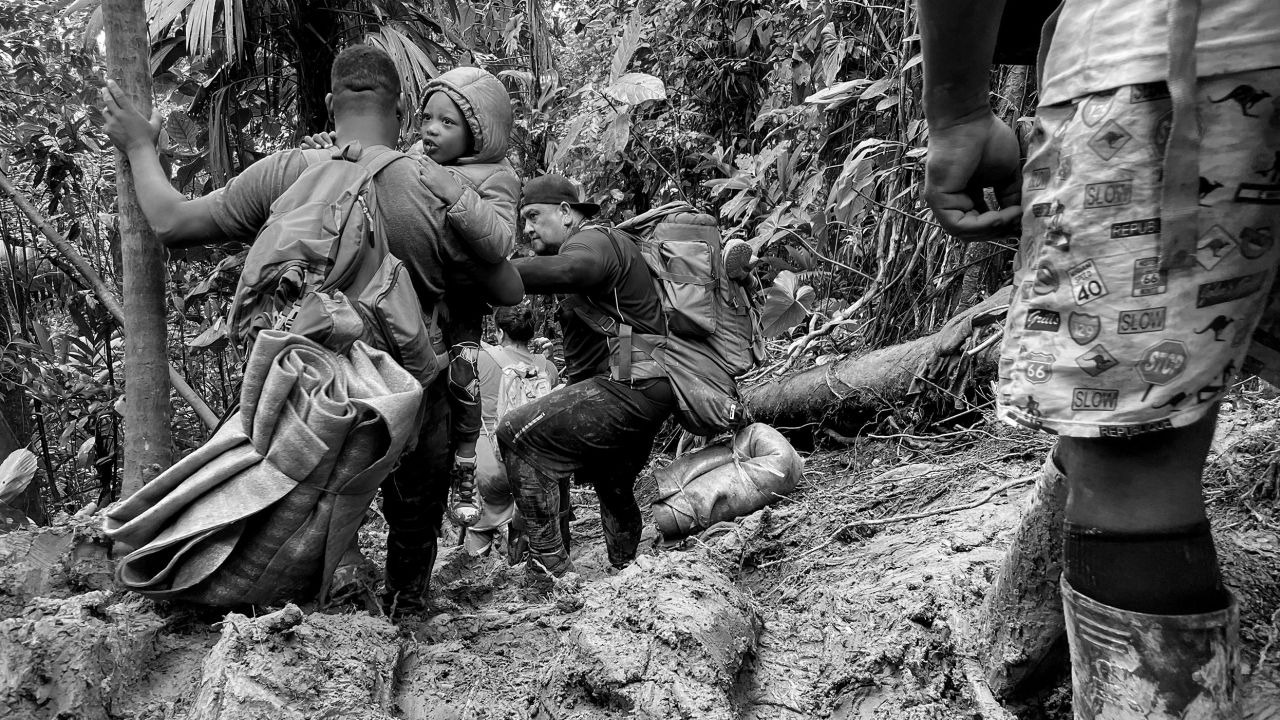
Tempers fray. “Why can’t you hurry the f**k up bitch,” a man shouts. He is reprimanded by an older lady in the same line, who reminds him a “proper father” would not talk that way.
Yet at other moments, the sense of community – of spontaneous care for strangers – is startling. One river crossing is deep and marked by a rope. You must carry your bag overhead, and many stumble. Younger Haitian men stay behind to help others cross, forming a human chain.
But this generosity can’t help with the physical pain or blunt the anxiety about what lies ahead.
Standing on the riverbank, watching others stumble through the water, Carolina, from Venezuela, weeps. “Had I known, I would not have come or let my son come through here,” she says. “This is horrible. You have to live this to realize crossing through this jungle is the worst thing in the world.”
Exhaustion is beginning to dictate every move. We stop next to the river to camp, and after an hour the site is overflowing with migrants, seeking safety in numbers and a pause. Dusk is setting in.
In one of the tents is Wilson, the five-year-old. He has reunited with his parents again, who caught up with him on the route. His father says his son is in good health, despite having surgery nine months earlier.
Outside another tent is Yendri, tending to her mother, whose right hand is raw with blisters after walking with a stick and wet leather gloves. She and Maria are also out of food, having given it away to other migrants, as they too thought the trek was just two or three days long.
But deprivation is not new to so many on the riverbank. Venezuelans talk around the campfires of waiting in line from 1 a.m. to buy groceries but leaving empty-handed at 6 p.m.
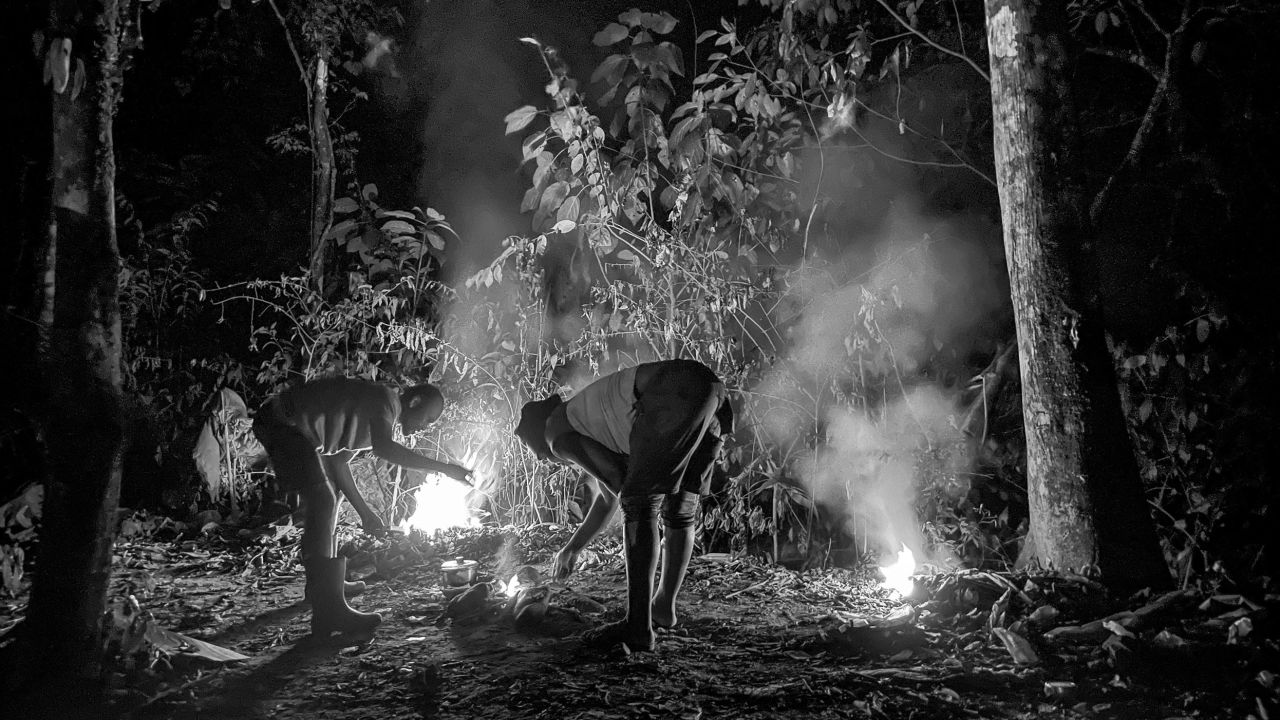
“You’d get to the end of the line and there was no food. Nothing. We’d last two, three nights and that’s when I decided [to leave],” Lisbeth, a mother from Caracas says, as she begins to cry.
Some even joke they are eating better in the jungle than in the Venezuelan capital.
The next morning, the migrants pass a black plastic canopy stretched across four poles. Locals tell us that before this new route opened, it was an overnight stop for thieves. It’s close to Tres Bocas, a busy confluence in the rivers, where an old migrant route meets this new one.
The two routes are now, it seems, competing, with safety and speed their rivaling commodities. Locals tell us the cartel has been fighting internally and fracturing. The new path was created as part of that fissure, but it is unclear whether it will be any more secure. Known as one of the world’s most dangerous migrant routes, the Darién Gap exposes those who cross it not only to natural hazards, but criminal gangs known for inflicting violence, including sexual abuse and robbery.
The crowds fall away at the mouth of the old route, a riverbed leading to Cañas Blancas, a mountain crossing into Colombia. It’s lined with trash – ghostly plastic hangs from the trees, left there when the river flowed higher in rainy seasons past.
Clothes are still hanging from hastily erected washing lines. A child’s doll and rucksack lie abandoned. The density of refuse reflects the number of people who’ve walked the route over the last decade – some of whom did not make it out.
We soon stumble upon a few of them. A corpse wearing a yellow soccer jersey and wristband, his skull exposed. Further up the path, a foot can be seen sticking out from under a tent – a makeshift cross left nearby in hurried memorial. Elsewhere, the body of a woman, her arm cradling her head. According to the IOM, 36 people died in the Darién Gap in 2022, but that figure is likely only a fraction of the lives lost here – anecdotal reports suggest that many who die on the route are never found or reported.

Another mile upstream is what appears to be a crime scene. Three bodies lie on the ground, each about 100 yards from each other. The first is a man, face down on the roots of a tree, rotting on a pathway. The other two are women. One is inside a tent, on her back, her legs spread apart. The third is concealed from the other two behind a fallen tree along the riverbank. She lies face down, found by migrants, according to photographs taken three weeks earlier, with her bra pushed up around her head. There are injuries around her groin and a rope by her body.
A forensic pathologist who studied photographs of the scene at CNN’s request and didn’t want to be named discussing a sensitive issue, said there were likely signs of a violent death in the case of the one woman with a rope near her body, and the other two bodies – the man and woman – likely, “did not die of natural causes.”
Yet there is unlikely to be an investigation. Panamanian authorities were told by journalists about the incident weeks prior, but there is no indication they have been here. Migrants just walk by the scene, a cautionary tale. No graves, just a moment of respect – afforded by discarded tent poles, fashioned into a cross.
Nearby is Jorge, who is on his second bid to cross into the US, where his brother lives in New Jersey. His first attempt ended with deportation back to Venezuela. Both of his journeys have been marred by violence. Just days earlier, further up the old route near the Colombian border, men in ski masks robbed his group.
“When we were coming down Cañas Blancas, three guys came out, hooded, with guns, knives, machetes. They wanted $100 and those that didn’t have it had to stay. They hit me and another guy – they jumped on him and kicked him,” he said, adding the group had to borrow from other walkers to pay the $100. “That’s the story of the Darién. Some of us run with luck. Others with God’s will. And those that don’t pass, well they stay and that’s the way of the jungle.”
At night, talk of the violence and robbery spreads through the group. Their tents are pitched closer together, and they burn plastic to heat food, choking the air, at times risking catching the trees alight.
The closing hours of the walk, that next dawn, see great sacrifice among the migrants. And with the end in sight, nobody is willing to leave anyone else behind.
Along one riverbed, a crowd has formed around a Venezuelan man in his early 20s, named Daniel. His ankle has swollen red from injury. Of the 10 days he’s spent in the wild, he’s been here for four.
Other Venezuelans are busy around him, finding food and medicine. One injects him with antibiotics. Four other men, strangers to Daniel until 30 minutes earlier, fashion a stretcher from nearby branches, and carry him on, constantly joking among themselves. “That man is crazy. In the US, don’t they have psychologists to help this guy?” one says.
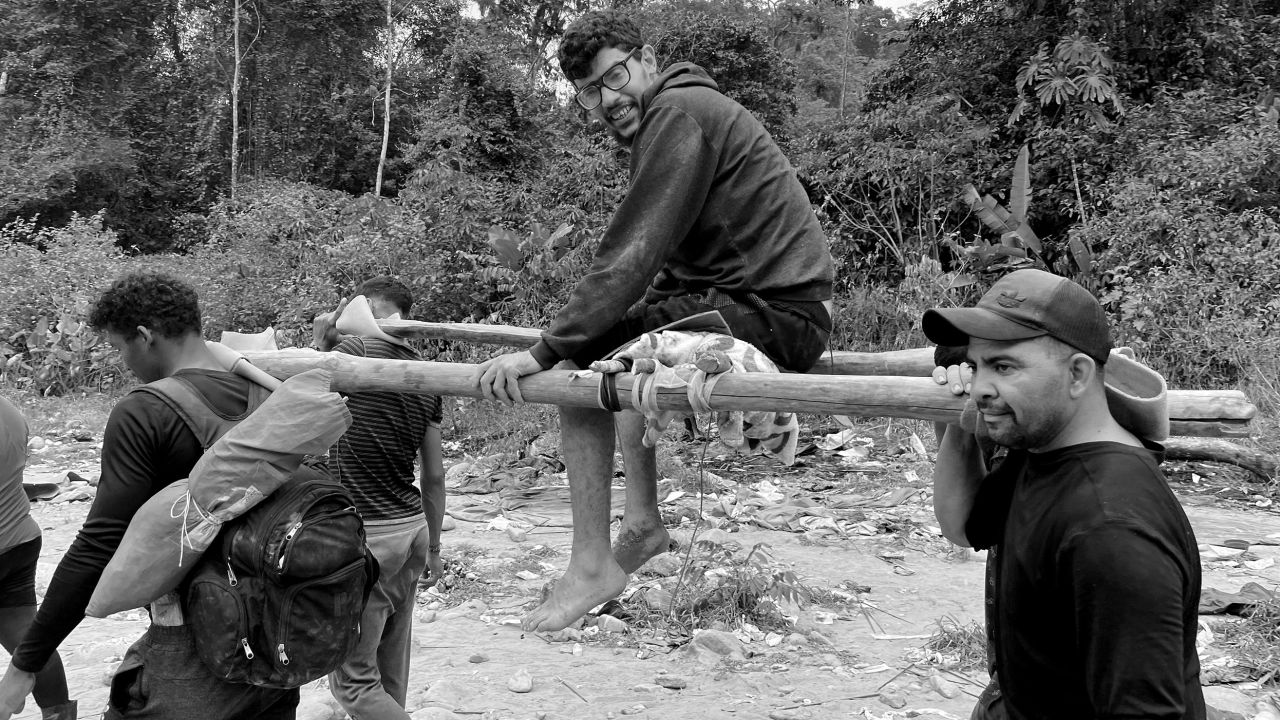
A woman from Haiti, Belle, is five months pregnant and quiet. She is shaking from hunger and thirst. She too gets help – food and water from other migrants.
Anna, the 12-year-old girl who is disabled, and was stranded on a hillside after being separated from her mother, is still moving forwards. For a day now, she has been carried on the back of one man: Ener Sanchez, 27, from a Venezuelan-Colombian border town. Exhausted, he says: “I have to wait for her mother because we can’t leave her.”
The heat is extreme, and the boats appear to always be further than imagined along the rocky, impassable riverbed. One Haitian woman lies on the path, water poured on her head by friends to cool her down.
And when they finally reach the boats, their ordeal is not over, but extended. Lines curve along the riverbank for each canoe – wooden vessels known as “piraguas” crammed full of migrants each paying $20 a head. The boats arrive constantly, perhaps six at a time, to cater to the volume of migrants – each making $300 when full.
Fights break out among the exhausted over who is first in line. A medical rescue helicopter passes overhead, the first sign of a government presence since we entered Panama three days earlier.
Carolina is here, trying to board. Fatigue overshadows her relief. “Nobody knows but this jungle is hell; it’s the worst. At one point on the mountains, my son was behind me, and he would say, ‘Mom, if you die, I’ll die with you.’” She says she told her son to relax. “My legs would tremble, and I would grab on to tree roots. There was a moment when the river was too deep for me. I saw my son put a child on his shoulders and he told me, ‘Mom, I am going to help. Don’t worry, I am okay.’”
“I regret putting my son through this jungle of hell so much that I have had to cry to let it all out because I risked his life and mine,” she adds, gazing toward the river.
The boats struggle to float, each too weighed down by passengers in the shallow water of the dry season. Only when some migrants get out to push can they progress, and even that causes a jam. They pass a human skull on a log. And an hour down the river, they arrive in Bajo Chiquito, the first immigration station in Panama, where they are offered first aid, basic services and are processed by authorities.
The government-run station is not designed for this many. Processing is meant to take a matter of hours before they are moved to camps while they await passage onwards to Costa Rica, Panama’s neighbor to the north. But many are stuck here with the backlog. Sodas cost $2. Some hurriedly buy new shoes or flip-flops for $5.
Even if you are lucky enough to leave this crowded center, there is no respite. Panamanian authorities are keen to show us two migration reception centers, which wildly differ.
One is San Vicente, a recently renovated facility with windows, clean beds, and plumbing, that separates women from men. Water springs from the faucets and shade from the sun is plentiful. The only complaints we hear are between different nationalities about who is treated better. But it hasn’t always been this nice.
The camp was mentioned in a UN report released in December of last year, which strongly criticized the conditions in Panamanian immigration centers and even accused Panamanian officials of soliciting sexual favors from migrants in exchange for a seat on the buses headed north.
According to the report, the UN received complaints that employees from the SNM [National Migration Service of Panama] and SENAFRONT, the Panamanian national border force, “requested sexual exchanges from the women and girls housed in the San Vicente Migration Reception Center who lack the money to cover the aforementioned transportation costs, with the promise of allowing them to get on the coordinated buses by the Panamanian authorities so that they can continue their journey to the border with Costa Rica.”
The Panamanian government did not respond to CNN’s request for comment on allegations that SNM and SENAFRONT employees sexually exploited women and girls at San Vicente.
The other camp, called Lajas Blancas, is an extension of the migrants’ suffering. There, the next day, we meet Manuel and Tamara again.
Lajas Blancas also cannot cope with the numbers. Lines form for lunch, yet a loudspeaker soon says portions have finished. The couple got here early in the morning, walking at night from Bajo Chiquito. Now they are reeling from how poor the conditions are in this place they have fought to reach. Buses go from here to the border if you have the money.
“When I got here in the early morning, only four buses left,” Manuel says. Next to him, one of his sons vomits onto the plastic mattress they are all trying to rest on. “The oldest, 5-year-old, has diarrhea, fever and [has been] throwing up since yesterday. Our 1-year-old has heat stroke. All that we want is a bus,” he says.
Other migrants have endured weeks at the camp, some even working as cleaners in filthy conditions to earn a seat on a bus. “They put us to clean two weeks ago,” said a Colombian man of the camp, which is run by SENAFRONT. “But the buses came last night, and they took everyone with money.”
SENAFRONT did not reply to CNN’s request for comment regarding the conditions at Lajas Blancas.
A pregnant woman adds: “We’ve been here for nine days. I’ll be close to giving birth here. They don’t give us answers. They have us working and don’t give us a ‘yes, it’s [time] for you to leave.’ In the end, they lie to us.”
Diarrhea, lice, colds – the complaints grow. They point towards the appalling hygiene of the shower blocks, where dirty water just drains onto the ground outside. The nearby wash basins are worse: no water and human feces on the floor.
“The whole point of surviving the jungle was for an easier way forwards, and now all we are is stuck,” says Manuel. “I was starting to have nightmares. My wife was the strong one. I collapsed.”
Their dream of freedom must wait, for now replaced by servitude to a system designed to make them pay, wait, and risk – each in enough measure to drain their cash slowly from them, and keep them moving forward to the next hurdle.
[ad_2]
Source link










